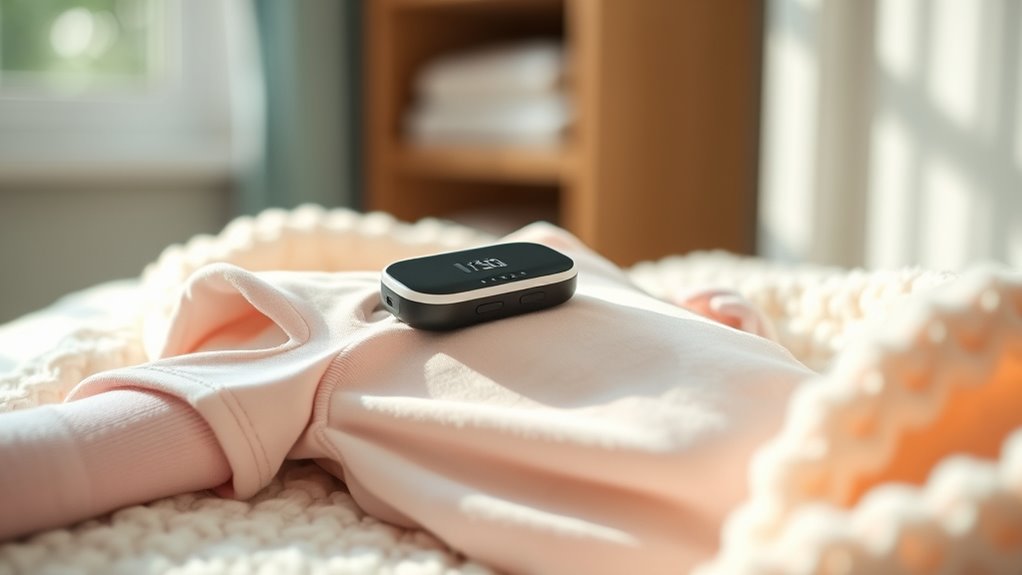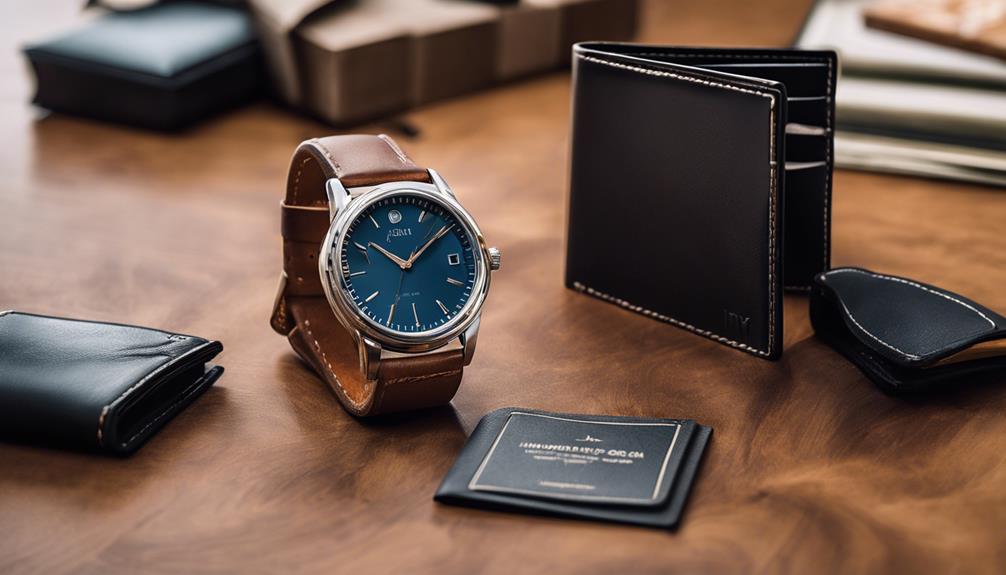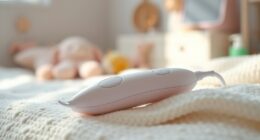If you’re looking for the best wearable baby breathing monitors to keep your little one safe, I recommend checking out options like the Owlet Dream Sock, Babytone Sleep Sock, HALO SleepSure, and Lovana Oma Sense. These devices track essential signs, motion, and oxygen levels, offering real-time alerts and monitoring features. Each one has unique benefits for comfort and safety. Keep going—I’ll share detailed insights to help you choose the right one.
Key Takeaways
- Wearable monitors like Owlet Dream Sock and Babytone Sleep Sock track vital signs such as heart rate and oxygen levels in real-time.
- Devices such as Lovana Oma Sense and Babysense 7 monitor abdominal movements and breathing without intrusive sensors.
- Many models offer instant alerts, sleep tracking, and environmental monitoring to enhance infant safety during sleep.
- Safety features include secure data encryption, low radiation technology, and compliance with safety standards.
- Ease of use, comfort, and reliable connectivity are key factors in choosing effective wearable baby breathing monitors.
Owlet Dream Sock® Baby Monitor with Heart and Oxygen Tracking
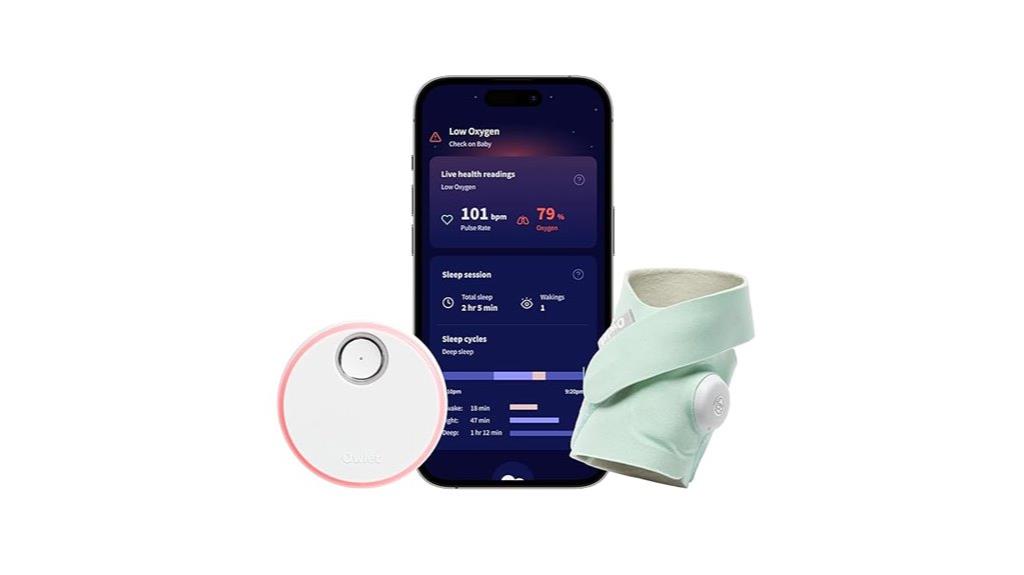
If you’re looking for a reliable way to monitor your baby’s essential signs, the Owlet Dream Sock® Baby Monitor is an excellent choice, especially for parents with infants who have health concerns or are in the NICU. This FDA-cleared device tracks pulse rate, oxygen levels, sleep patterns, and wakings in real-time via the Owlet app. Its soft, adjustable fabric guarantees comfort, while the base station provides immediate alerts through lights and sounds if readings fall outside preset ranges. Compatible with iOS and Android, it offers up to seven days of battery life, giving parents peace of mind during sleep and recovery periods.
Best For: parents of infants with health concerns, NICU babies, and those seeking peace of mind through real-time monitoring of pulse, oxygen, and sleep patterns.
Pros:
- Provides accurate, real-time health data via user-friendly app for early detection of issues.
- Soft, adjustable sock ensures comfort and a snug fit for growing babies.
- Includes a base station with lights and sounds for immediate alerts, enhancing safety.
Cons:
- Device lifespan is typically only 11-12 months, with many users experiencing failure afterward.
- Limited warranty (12 months) and regional restrictions make support and usage outside the U.S. challenging.
- App bugs, data logging intervals, and durability concerns may affect long-term reliability.
Babytone Baby Sleep Sock Monitor

The Babytone Baby Sleep Sock Monitor is an ideal choice for parents who want a reliable, comfortable way to track their infant’s essential signs overnight. I appreciate its soft, breathable nylon sock that stays comfortably in place, even with active kicking. Designed for babies aged 0-36 months, it monitors heart rate, oxygen levels, and movement, providing real-time data via the ViHealth app. The device stores multiple sessions and uploads data when Bluetooth reconnects, giving me peace of mind. Lightweight and easy to use, it’s perfect for monitoring sleep patterns and detecting irregularities, especially when healthcare reassurance is a priority.
Best For: parents of infants aged 0-36 months seeking a comfortable, reliable way to monitor their baby’s heart rate, oxygen levels, and sleep patterns overnight.
Pros:
- Soft, breathable nylon sock ensures comfort and stays securely in place during active sleep.
- Provides real-time vital sign data through the easy-to-use ViHealth app, offering peace of mind.
- Stores multiple sleep sessions and syncs automatically when Bluetooth reconnects, facilitating tracking over time.
Cons:
- Occasional connectivity issues or sock displacement due to kicking may require adjustments.
- Requires continuous Bluetooth connection for live updates, which may drain device battery or cause interruptions.
- Not compatible with fast chargers, needing a specific 5V1A USB-A power source for recharging.
HALO SleepSure Baby Monitor with Heart Rate, Temperature & Motion Alerts
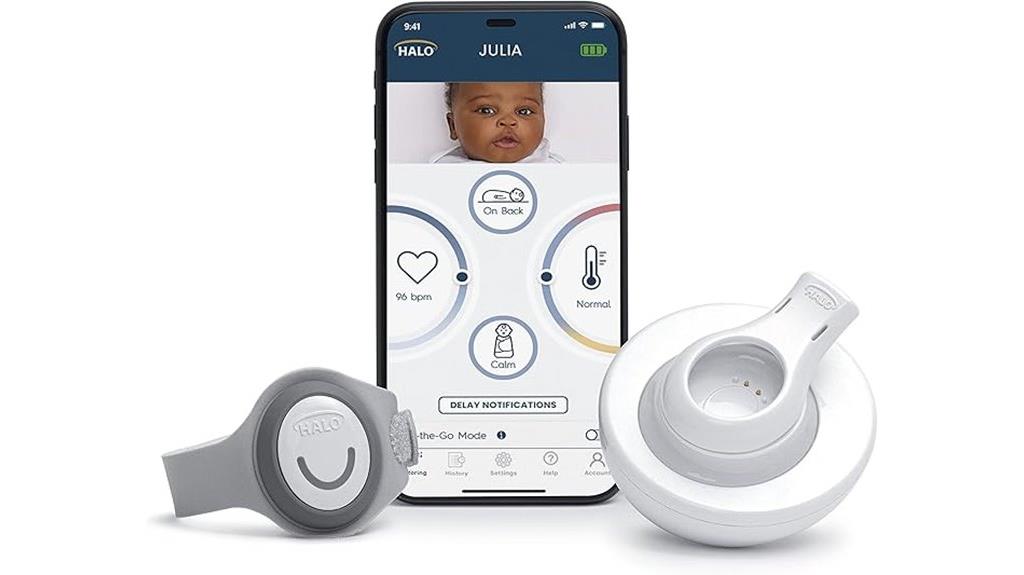
The HALO SleepSure Baby Monitor stands out for parents seeking real-time insights into their baby’s essential signs, especially heart rate, temperature, and motion. It tracks four critical sleep metrics and sends alerts for skin temperature changes, rollover, and movement, promoting safety and comfort. The monitor connects to a free mobile app on Android and iOS, allowing remote viewing and notifications during travel. Its fabric band wraps around the baby’s calf for accurate readings, and setup is quick with Wi-Fi pairing. With a 24-hour battery, it’s user-friendly and perfect for monitoring infants up to 18 months, helping parents stay informed and reassured.
Best For: parents of infants aged 0-18 months who want real-time monitoring of heart rate, temperature, and motion with remote access and customizable alerts.
Pros:
- Tracks four vital sleep metrics in real-time, including heart rate, skin temperature, rollover, and movement.
- Connects to a free mobile app for remote viewing and notifications on Android and iOS devices.
- Features a comfortable fabric band for accurate readings and quick Wi-Fi setup with a 24-hour battery life.
Cons:
- Only supports monitoring one baby at a time, not suitable for twins or multiples.
- Compatibility limited to the USA for the mobile app, restricting use in other regions.
- Requires a calf wrapping, which may be less convenient than other monitoring methods.
Lovana Oma Sense Baby Breathing Monitor with Vibrations and Alerts
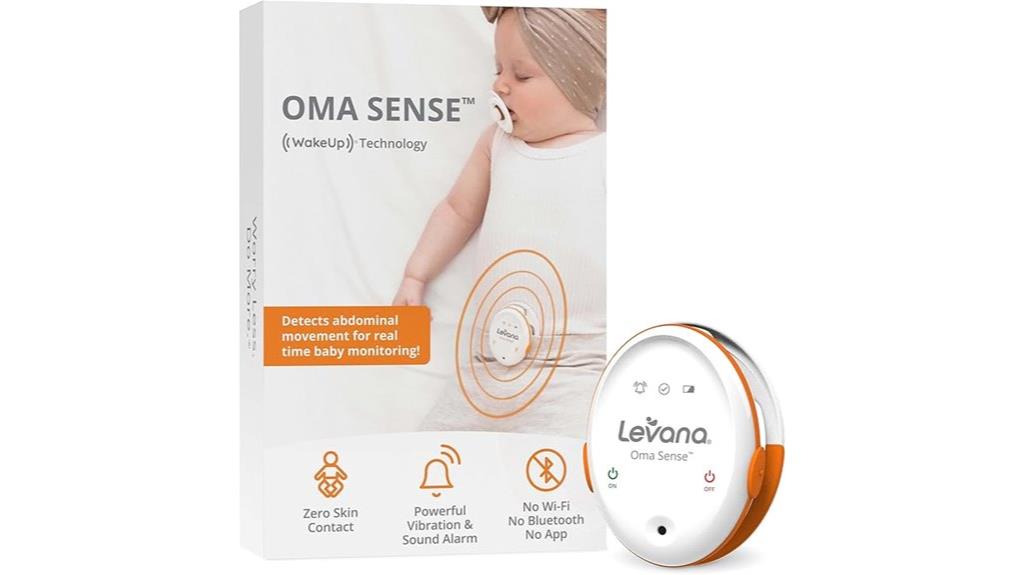
For parents seeking a non-intrusive way to monitor their infant’s breathing, the Lovana Oma Sense Baby Breathing Monitor offers a compelling solution. This portable device slips easily over a diaper, onesie, or pants, avoiding skin contact and eliminating the need for WiFi or Bluetooth. It uses patented Wakeup Technology to track abdominal movements continuously. If no movement is detected for 15 seconds, it gently vibrates to stimulate the baby. If movement doesn’t resume within five seconds, an audible alarm sounds, alerting caregivers. Designed in Canada from hypoallergenic, medical-grade materials, it’s lightweight, reliable, and easy to use, providing peace of mind during sleep.
Best For: parents seeking a reliable, non-intrusive baby breathing monitor that offers peace of mind without requiring app connectivity.
Pros:
- Easy to slip over diaper or onesie without skin contact, making it comfortable for the baby.
- Uses patented Wakeup Technology for continuous movement monitoring and gentle stimulation.
- No WiFi or Bluetooth needed, ensuring privacy and reducing setup complexity.
Cons:
- False alarms may occur due to swaddling, rolling, or improper attachment.
- Limited effectiveness once the baby starts rolling or sleeping on their side.
- The alarm and vibration might be insufficiently loud for heavy sleepers or noisy environments.
Babysense 7 Baby Sleep and Breathing Monitor
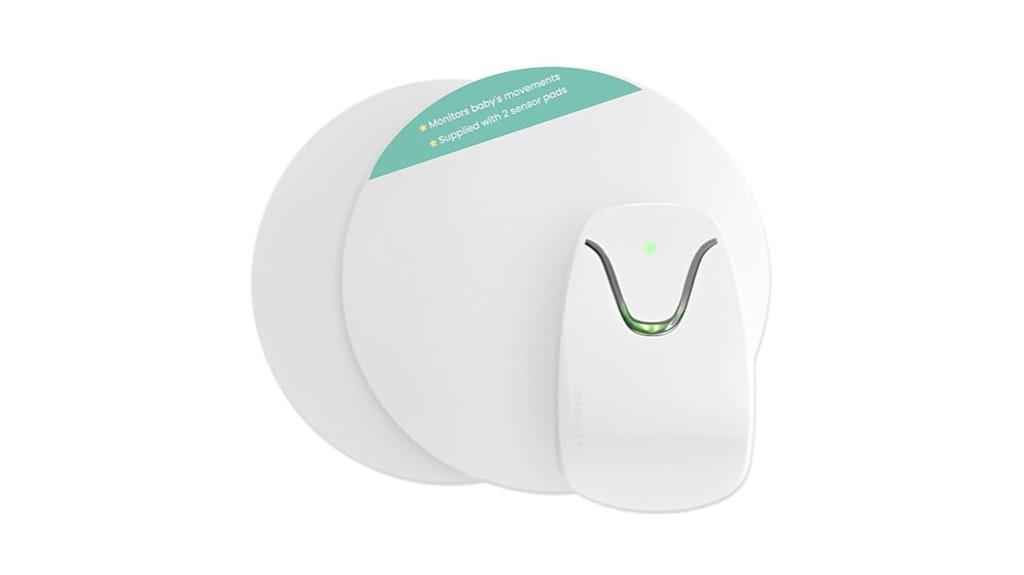
If you’re seeking a reliable way to monitor your baby’s breathing without attaching devices directly to them, Babysense 7 offers a safe, non-contact solution. It uses two under-mattress sensors to detect tiny movements, including breathing, through the mattress. Approved by HSA/FSA, it guarantees safety and compliance. The sensors provide full crib coverage, reducing false alarms with enhanced sensitivity. It’s easy to set up, with a one-button operation, and features a 7-inch screen for easy monitoring. Many parents appreciate its peace of mind, though some find the alarm volume a bit quiet. Overall, Babysense 7 stands out for its safety, reliability, and extensive coverage.
Best For: parents seeking a safe, non-contact breathing monitor that provides full crib coverage and reduces false alarms for newborns and infants.
Pros:
- Non-contact sensors ensure safety and comfort without attaching devices to the baby
- Full crib coverage with two sensitive under-mattress sensors enhances monitoring accuracy
- Easy to set up with a simple one-button operation and a clear 7-inch screen
Cons:
- Alarm volume may be quieter than some parents prefer, requiring pairing with a separate monitor for better alerting
- Not compatible with memory foam mattresses, limiting placement options
- LED indicator lights could be more intuitive, with suggestions for clearer, traffic light color coding
Nanit Pro Smart Baby Monitor & Floor Stand with Breathing Band
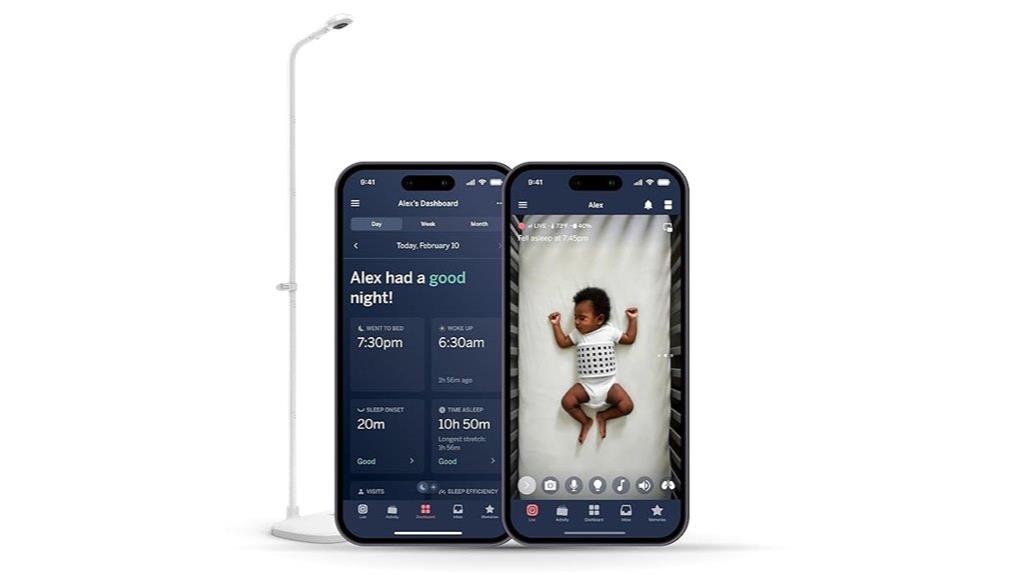
Looking for a reliable way to monitor your newborn’s breathing without intrusive sensors? The Nanit Pro Smart Baby Monitor with Floor Stand and Breathing Band offers just that. It features 1080p HD video, two-way audio, and a companion app for real-time monitoring from anywhere. The small, sensor-free Breathing Band tracks your baby’s breathing movements safely, perfect for infants 0-3 months. It also includes sleep tracking, personalized insights, and instant notifications for events like crying or coughing. With secure data encryption and multi-user access, it keeps your baby’s safety and privacy a top priority. Plus, the floor stand makes setup easy and flexible.
Best For: parents of newborns and infants seeking a safe, reliable, and non-intrusive way to monitor their baby’s breathing, sleep, and overall safety remotely.
Pros:
- High-quality 1080p HD video with real-time streaming via app
- Sensor-free Breathing Band ensures safe monitoring for infants 0-3 months without sensors
- Secure data encryption and multi-user access protect privacy and enable team monitoring
Cons:
- Requires Wi-Fi connection for full functionality and remote access
- Subscription needed for advanced insights and smart home integrations (e.g., Alexa, Google Home)
- May be less suitable for older babies or toddlers who need different monitoring features
Sense-U Smart Baby Monitor Pro with Arousal Vibration and App Alerts
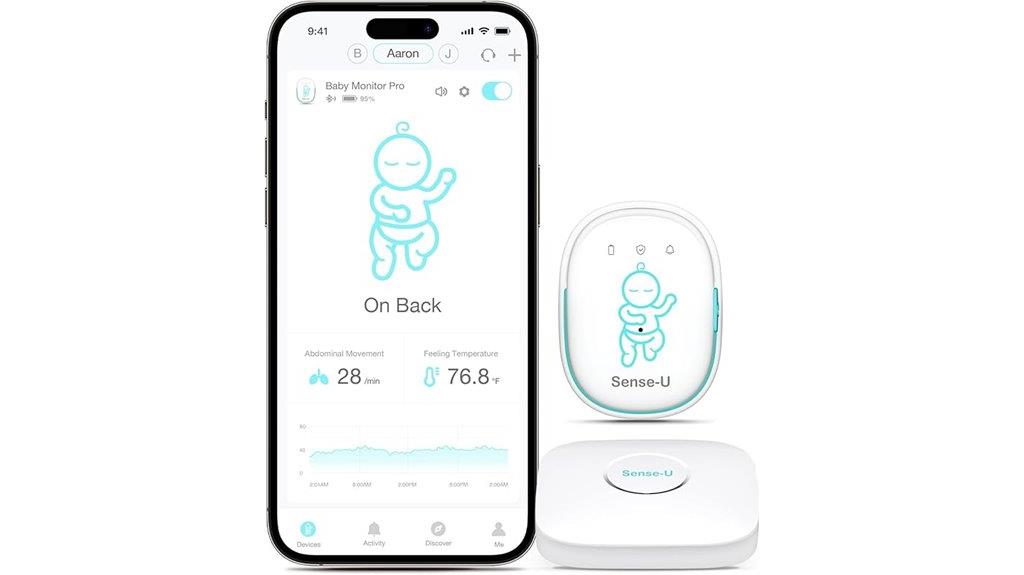
The Sense-U Smart Baby Monitor Pro stands out as an ideal choice for parents concerned about monitoring infant breathing and safety, especially those with newborns or babies prone to apnea. It clips onto diaper or pants, tracking abdominal movement, sleep position, temperature, and humidity. Its arousal vibration stimulates breathing if no movement is detected, while audible alerts and app notifications provide real-time updates. Supporting twin monitoring and environmental tracking, it’s safe with low radiation technology. The device is easy to use, with a long-lasting battery, and offers peace of mind through continuous essential sign monitoring, making it a reliable tool for safeguarding your little one.
Best For: Parents seeking a reliable, easy-to-use baby monitor that offers comprehensive safety features, including breathing and environmental monitoring, especially for infants with apnea or NICU history.
Pros:
- Long battery life lasting up to 30 days, reducing frequent charging needs
- Vibration stimulation and alerts provide real-time safety responses for breathing irregularities
- User-friendly app with remote access and twin monitoring support for added convenience
Cons:
- Limited camera sharing options, only supporting sensor data sharing currently
- Wi-Fi camera operates only on 2.4 GHz, requiring network adjustments for dual-band routers
- May require additional adapters for international outlet compatibility
Snuza Hero Baby Monitor
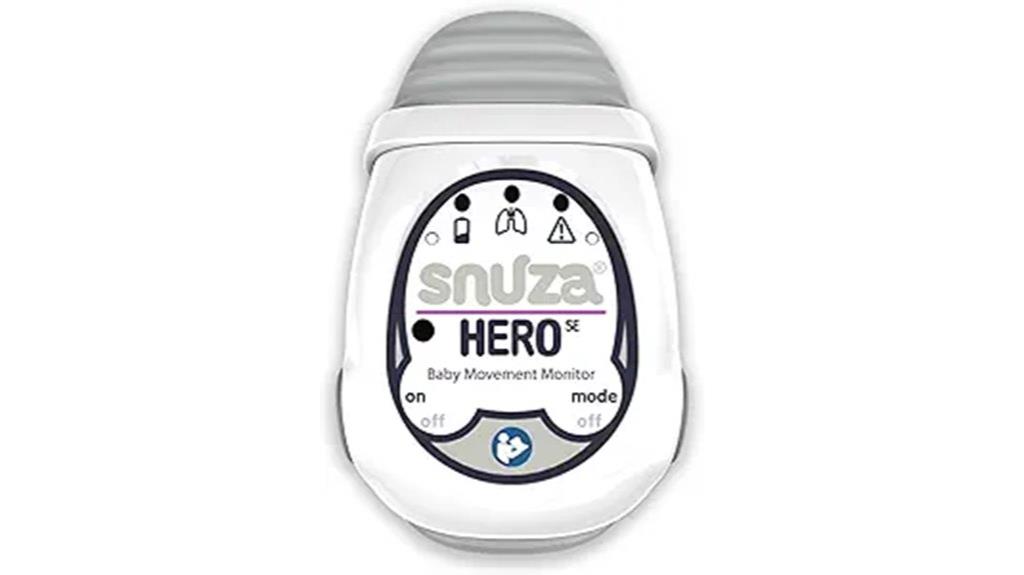
The Snuza Hero Baby Monitor stands out as an ideal choice for parents seeking a simple, reliable device that offers peace of mind without relying on WiFi or Bluetooth. It detects baby’s breathing movements using advanced sensor technology and alerts me if no movement is detected within 15 seconds, followed by a gentle alarm after five more seconds. The device clips securely onto the diaper and indicates proper contact with green lights and tick sounds. Made from medical-grade materials, it’s safe and easy to use, with a battery lasting up to six months. Overall, it’s a trustworthy tool that helps ensure my baby’s safety without complicated setup.
Best For: parents seeking a simple, reliable, and non-WiFi baby monitor that provides peace of mind through breathing movement alerts.
Pros:
- No WiFi or Bluetooth needed, ensuring privacy and straightforward use
- Long-lasting battery life of up to six months for minimal maintenance
- Easy to clip onto diaper or clothing, suitable for sleep environments and travel
Cons:
- False alarms can occur if the device shifts or the baby wiggles excessively
- The alarm volume may be insufficient for some parents from a distance
- Best used until about one year old, so may not be suitable for extended monitoring past infancy
Luna WiFi Baby Camera Monitor & Floor Stand
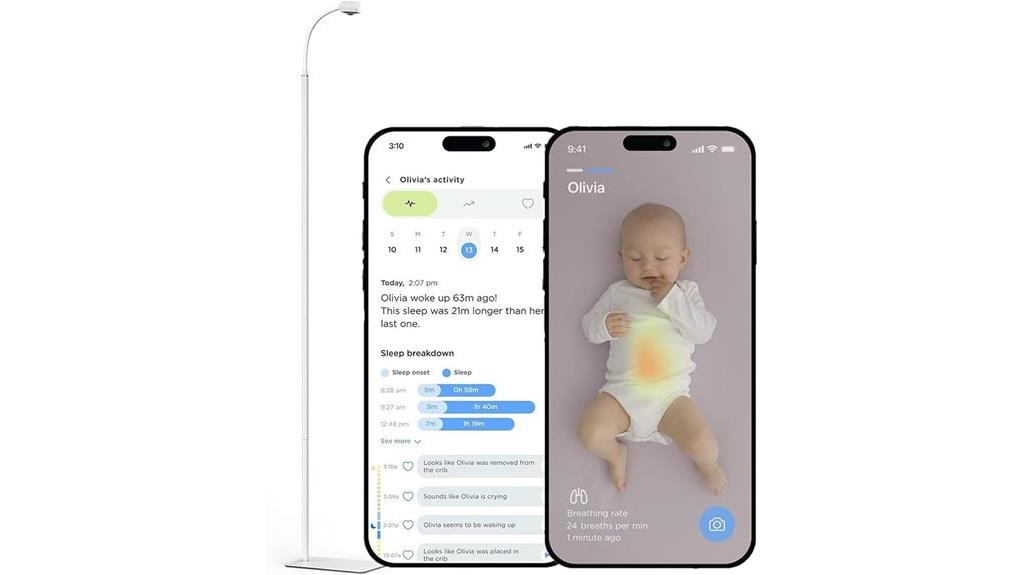
For parents seeking a reliable, non-wearable monitoring solution, the Luna WiFi Baby Camera Monitor with Floor Stand offers a smart way to keep an eye on their little one. It features real-time breathing detection, cry alerts, and sleep logs, giving you detailed insights without attaching anything to your baby. With night vision, two-way audio, and HD video, you can check in anytime—day or night. The included floor stand provides secure, top-down crib monitoring. While setup can be tricky and WiFi stability issues exist, many parents appreciate its all-encompassing features, making it a valuable tool for monitoring your baby’s safety and sleep patterns.
Best For: parents who want a comprehensive, non-wearable baby monitoring solution with real-time safety and sleep tracking features.
Pros:
- Offers detailed sleep, breathing, and activity logs without attaching anything to the baby
- High-quality HD video with night vision and two-way audio for clear communication
- Includes a sturdy floor stand for secure top-down crib monitoring
Cons:
- WiFi connectivity can be unstable, leading to disconnections and setup difficulties
- App may experience lag, bugs, and challenges with camera resets and subscription management
- Initial setup can be tricky, especially with small QR codes and limited multi-user access on the free plan
Hubble Connected Dream+ Baby Movement Monitor with HD Camera
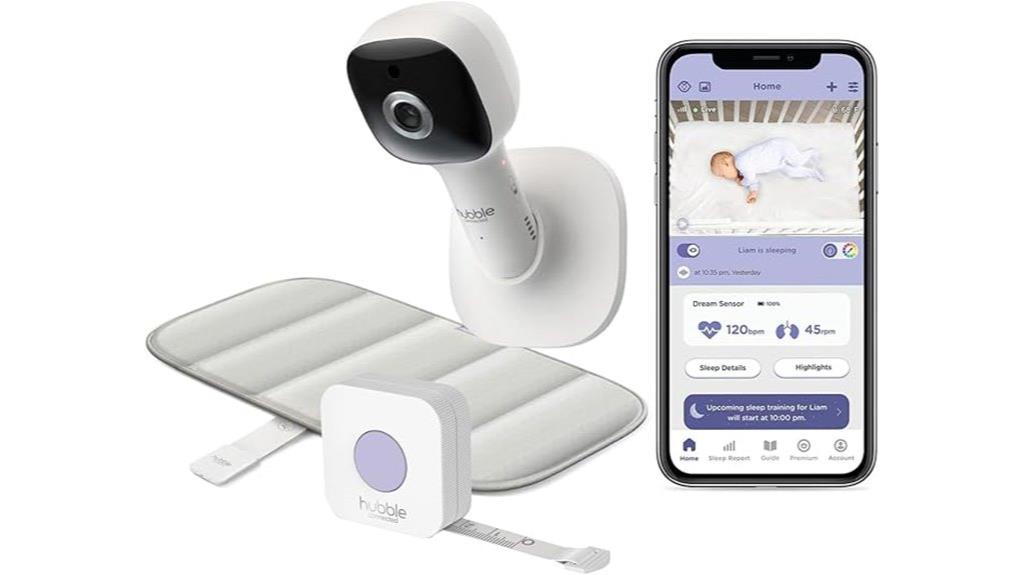
If you’re looking for a non-wearable solution that combines detailed sleep and health monitoring with high-quality video, the Hubble Connected Dream+ Baby Movement Monitor with HD Camera is an excellent choice. It uses a sensor mat beneath the mattress to track heart rate, breathing, and movement, providing real-time updates and sleep scores through the app. The system also includes an HD Wi-Fi camera with pan, tilt, zoom, and two-way audio, letting you monitor your baby remotely. With growth tracking tools and soothing sounds, it offers all-encompassing oversight of your baby’s well-being, all from a user-friendly app. It’s a reliable option for parents seeking detailed, non-intrusive monitoring.
Best For: parents seeking a comprehensive, non-wearable baby monitoring system with advanced sleep tracking, high-quality video, and remote access capabilities.
Pros:
- Accurate health and sleep monitoring via sensor mat and app integration
- High-quality HD camera with pan, tilt, zoom, and two-way audio for remote supervision
- User-friendly app with growth tracking, sleep scores, and soothing sounds
Cons:
- Occasional connectivity issues and camera disconnections reported by users
- Sensor pad size may not be suitable for older infants or larger babies
- Some features require additional subscription costs, and setup can be challenging for some users
Philips Avent Premium Baby Monitor with 1080p Camera and App
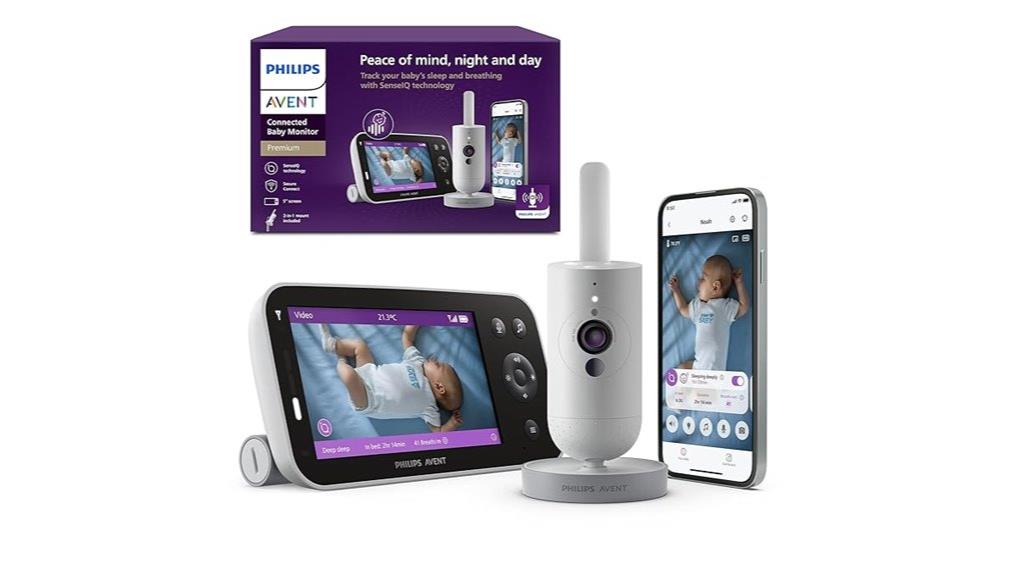
Parents seeking a high-quality, non-wearable monitor will appreciate the Philips Avent Premium Baby Monitor with 1080p camera and app. It features sharp 1080p video, night vision, digital zoom, and flexible mounting options. The 5” HD parent unit offers up to 12 hours of battery life and connects securely via encrypted links. You can monitor remotely with the Baby Monitor+ app, which also provides sleep insights, cry detection, and room temperature data. Additional features include a nightlight, white noise, lullabies, and two-way talk. While it’s not medical-grade, it offers reliable video, sound, and breathing pattern monitoring, making it a *extensive* choice for peace of mind.
Best For: parents seeking a comprehensive, high-resolution baby monitor with advanced features and remote monitoring capabilities without the need for wearable devices.
Pros:
- Sharp 1080p video quality with night vision and digital zoom for clear visuals.
- Secure, encrypted connection ensuring privacy and data protection.
- Long-lasting battery life up to 12 hours and versatile mounting options for easy setup.
Cons:
- Cry detection can be unreliable and may require calibration.
- Night light may be too dim for some preferences.
- Price point around $350 may be considered expensive for some users.
Babytone Baby Sleep Monitor with Base Station
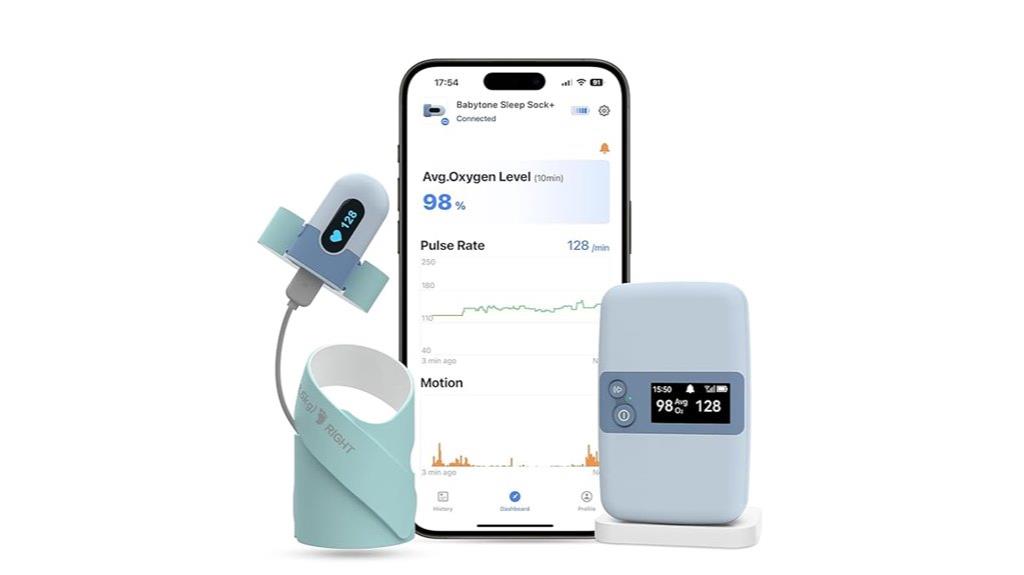
The Babytone Baby Sleep Monitor with Base Station stands out as an ideal choice for caregivers seeking a reliable, non-invasive way to monitor infant sleep and essential signs overnight. This wearable smart sock tracks heart rate, oxygen saturation, and movement, providing real-time alerts for irregularities. It connects via Bluetooth to a user-friendly app, allowing me to view sleep data, export records, and monitor trends. The device offers up to 16 hours of battery life and a base station that lasts seven days on a single charge. Its soft, washable sock fits comfortably, making it a convenient, affordable option for keeping my baby safe and reassured throughout the night.
Best For: parents and caregivers seeking a non-invasive, reliable sleep monitoring device for infants aged 0-36 months to ensure peace of mind overnight.
Pros:
- Easy to use with real-time alerts and user-friendly app integration
- Long battery life of up to 16 hours for overnight monitoring
- Soft, washable sock provides a comfortable fit for babies
Cons:
- Occasional Bluetooth disconnections may require manual reconnection
- Custom charger can be difficult to replace or find spare parts
- Battery life may reduce over time with extended use
Factors to Consider When Choosing Wearable Baby Breathing Monitors
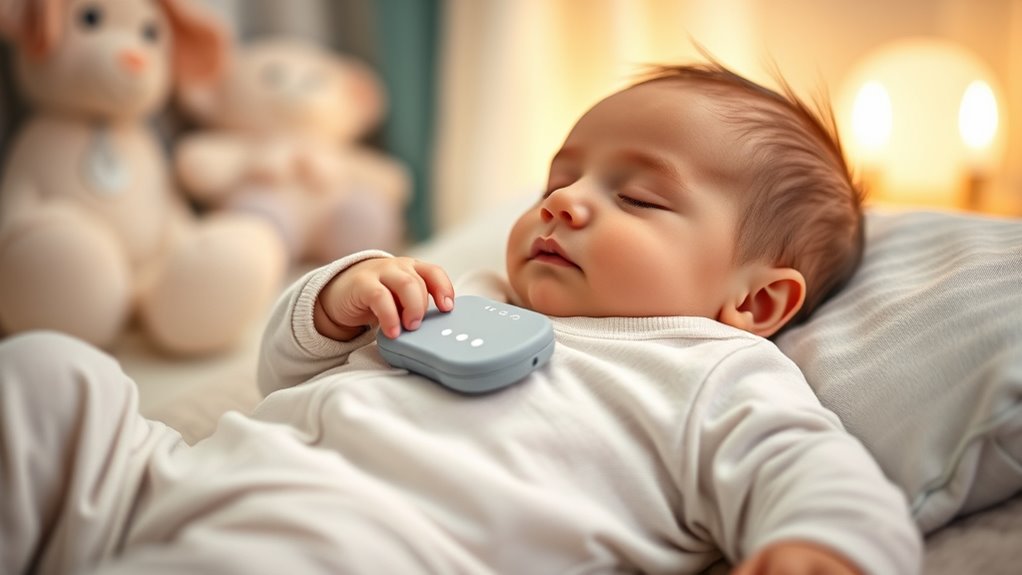
When choosing a wearable baby breathing monitor, I focus on key factors like accuracy, comfort, and safety to guarantee peace of mind. It’s also important to take into account battery life, connectivity, and the overall value, including warranty options. Let’s explore these points to help you pick the best monitor for your little one.
Monitoring Accuracy and Reliability
Choosing a wearable baby breathing monitor hinges on its ability to deliver accurate and reliable readings, which requires high-quality sensors capable of detecting even subtle movements and physiological signals. Reliable monitors use advanced algorithms to differentiate normal sleep motions from concerning signs like apnea or irregular breathing, reducing false alarms and missed events. Consistent data transmission via stable Bluetooth or Wi-Fi connections ensures real-time updates without delays. Devices that meet validated clinical or safety standards are more trustworthy, especially for at-risk infants or those with medical conditions. Regular calibration, proper placement, and following manufacturer instructions are essential to maintaining accuracy over time. Prioritizing these factors helps ensure you get dependable monitoring that keeps your little one safe.
Comfort and Fit
Ensuring your baby’s comfort and a proper fit is vital for effective monitoring without causing unnecessary disturbance. A comfortable monitor should be made from soft, hypoallergenic fabrics that won’t irritate delicate skin and can be worn during sleep without discomfort. The device needs to fit snugly enough to stay in place but not so tight that it restricts movement or causes pressure. Adjustable sizing options are essential, allowing the monitor to grow with your baby and prevent slipping or shifting during sleep. Lightweight designs, ideally under 4 ounces, help avoid adding pressure or interfering with natural sleep patterns. Additionally, a good fit should be easy to put on and remove, with secure fastenings that won’t leave marks or cause discomfort on your baby’s skin.
Battery Life and Connectivity
A wearable baby breathing monitor needs reliable battery life and stable connectivity to keep you informed and reassured. A longer battery life means continuous monitoring overnight or during extended periods without needing a recharge, ensuring peace of mind. Rechargeable batteries with at least 16 hours of power are ideal, preventing interruptions. Stable connectivity via Bluetooth or Wi-Fi is essential for real-time data transmission and alerts, reducing the risk of missed notifications. Devices with strong, consistent connections are more dependable, especially if they feature automatic reconnection capabilities that quickly restore data flow after disconnections. Disruptions in connectivity can lead to gaps in data and delayed alerts, so prioritizing monitors with robust, stable links will enhance safety and reliability for your little one.
Safety and Certification
When selecting a wearable baby breathing monitor, verifying its safety certifications is essential to guarantee it meets established medical standards. Look for devices with certifications like FDA clearance or approval, which ensure they have undergone rigorous testing and are safe for infants. Choose monitors made from hypoallergenic, non-toxic materials to prevent skin irritation and ensure safe contact. It’s also important to confirm the device has been tested for false alarms and reliable detection of breathing patterns, providing peace of mind. Additionally, check for compliance with regional safety regulations and standards relevant to your country, ensuring legality and safety. Ultimately, opt for products with clear safety warnings, proper labeling, and transparent information from manufacturers about safety testing and certifications.
Price and Warranty
Choosing a wearable baby breathing monitor involves more than just looking at its safety features; price and warranty also play a significant role in making a smart purchase. The cost can vary widely, from affordable options under $100 to premium models over $300. It’s vital to contemplate how long the warranty lasts—most range from 12 months to two years—and what it covers. Some warranties only address manufacturing defects, leaving damages from wear or misuse to you. Check if the warranty includes replacement parts, technical support, or free repairs, as these add value and reduce long-term costs. Keep in mind, devices with shorter warranties may lead to additional expenses for repairs or replacements once coverage ends. Balancing price and warranty helps ensure your investment is both affordable and reliable.
Frequently Asked Questions
How Accurate Are Wearable Baby Breathing Monitors in Detecting Abnormal Breathing?
When it comes to detecting abnormal breathing, I’ve found that wearable baby breathing monitors are generally quite accurate, but they’re not foolproof. They use sensors to track your baby’s breath patterns and alert you to irregularities. While technology has improved, I still recommend staying attentive and not relying solely on these devices. They’re a helpful tool, but always combine them with your watchfulness for your little one’s safety.
Can Wearable Monitors Be Used During Nap Times or Just Overnight?
Did you know that over 80% of parents use wearable monitors during naps and overnight? I find they’re quite versatile and safe for both times. I personally use mine during naps because I want constant reassurance that my baby’s breathing is normal, whether asleep for a short rest or the whole night. These monitors are designed to be comfortable and reliable, giving me peace of mind anytime my little one is sleeping.
Do Wearable Monitors Require Wi-Fi or Internet Connectivity?
You’re wondering if wearable monitors need Wi-Fi or internet? I found that many don’t require constant connectivity for basic functions like monitoring breathing or heart rate. They often store data locally or sync periodically. However, some models with app integrations do need Wi-Fi to send alerts or updates. I recommend checking each device’s specs to see if continuous internet is necessary for your peace of mind.
Are Wearable Baby Breathing Monitors Suitable for Newborns and Preemies?
Some parents worry if wearable baby breathing monitors are safe for newborns and preemies. I believe they are, as many are designed specifically for delicate infants, with soft materials and gentle alerts. These devices can provide peace of mind by monitoring breathing patterns closely. I recommend choosing models with adjustable sensitivity and comfortable fits, ensuring your tiny tot stays safe without discomfort or unnecessary alarms.
What Is the Battery Life and How Often Do They Need Charging?
Battery life varies depending on the model, but most wearable baby breathing monitors last about 24 to 48 hours on a single charge. I find it’s best to charge them nightly to make certain they’re ready for use each day. Some devices have quick-charging features, so I can top them up quickly if needed. Regular charging keeps the monitor reliable, giving me peace of mind knowing my baby is always protected.
Conclusion
Choosing the right wearable baby breathing monitor is like finding a trusty lighthouse in a foggy night—it guides you safely through uncertain waters. With so many options shining brightly, trust your instincts and consider what fits your little one’s unique needs. Remember, these devices are your vigilant guardians, turning restless nights into peaceful slumber. Here’s to keeping your tiny star safe, so you both can sleep soundly under the watchful glow of peace of mind.

